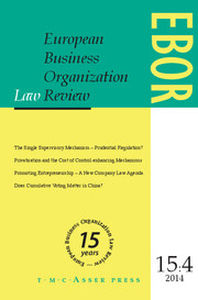Article contents
Regulatory approaches to groups of companies in Hungary
Published online by Cambridge University Press: 17 February 2009
Extract
The subject of this article is the development of group law in Hungary, which can already be traced back to the time before the fall of the iron curtain in 1989-1990. In particular, the Law on Commercial Companies (LCC) had already since 1988 contained several basic rules on group law. The evolution of Hungarian group law may be described as gradual and reactive. Whilst already in 1988 it had become conceivable that in the foreseeable future groups of companies and the legal problems inherent to them would gain significance, this situation had not then become sufficiently concrete to require a comprehensive legal solution.
- Type
- Articles
- Information
- Copyright
- Copyright © T.M.C. Asser Press and the Authors 2001
References
1 § 94 and §§ 94/A-94/H respectively, of Law no. CXI/1996.
2 Law no. VI of 1988.
3 Cf. in more detail II.2. infra.
4 Cf. amongst others Tamás, Sárközy in: A társasági törvény magyarázata (Commentary on the company act) (Budapest 1993) p. 576.Google Scholar
5 Law no. CXLIV of 1997.
6 Law no. LXXXVI of 1990, newly codified by no. LVII of 1996 on the prohibition of unfair trade practices.
7 It should be noted that in Hungarian law – at least in legislative texts – the terms of “group” or of “group law” are not used at all. However, they are commonly used in scholarly writing.
8 Cf. 4. infra.
9 Such contracts may not breach balancing rules or other cogent legal rules, otherwise they are null and void.
10 The Law on firms provides, for the private limited company in § 13, para. 4 (b) and for the public limited company in § 13, para. 5 (h)), that the fact that a company becomes subject to a significant or majority influence or a direct control, has to be published in the company register. According to § 10, para. 1 of the Law on firms, a company can only rely on a statement in the company register as against third parties when the statement has been published in the gazette of the company register, except when it proves that the statement was known to a third party already prior to publication.
11 The same is true when the registration is belated, until the time of registration.
13 An argument we do not find entirely convincing.
14 Cf. § 294, para. 2 LCC.
14 In praxi, however, this notion was also applied to the executive members of co-operative societies.
15 § 294, para. 2 LCC.
16 § 295, para. 1 LCC.
17 Cf. § 296, para. 1 LCC.
18 On the rights of creditors in more detail, cf. 5. infra.
19 § 296, paras. 2 and 3 LCC.
20 Law no. CXI of 1996 on the issue of securities, investment services and the stock exchange. One of the most important changes from the old LCC is the clear distinction between open and closed public limited company. The LCC in force contains various provisions on a number of points and not just on the formation of the company, as did the earlier LCC. The closed public limited company is regarded as the basic form of a public limited company, as opposed to the earlier LCC, which in connection with formation regarded the public limited company as the basic form.
22 § 94/E LS.
- 1
- Cited by


